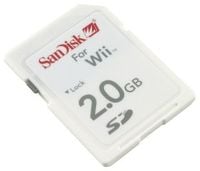Secure Digital cards, more commonly referred to as SD cards, are a digital, flash-based storage medium. Initially intended for digital cameras, SD cards have attained widespread use as a storage medium, and it has since been used on various Nintendo consoles as an alternate storage device.
In Super Smash Bros. BrawlEdit
The Wii has an SD card slot on the front of the console, with the console being able to write some data and software onto SD cards. The Wii only supported SD cards no larger than 2 gigabytes on launch, but later firmware updates allowed it to read SDHC cards, SD cards that can support over 2 gigabytes of data.
Standard save data for Brawl is not saved to SD cards, and instead, is stored on the Wii's own flash-based memory. SD cards, however, can be used to save snapshots, custom stages and replays from the Vault in order to be used or transferred on other Wii consoles. Brawl only supports SD cards that can support no more than 2 gigabytes of data, as it was released before the Wii could take advantage of SDHC cards and the game itself could not be patched in light of this. However, the game can be hacked to support SDHC cards.
In Super Smash Bros. for Nintendo 3DSEdit
The Nintendo 3DS has the ability to save downloaded software and various other types of data to an SD card, and all iterations of the console come packaged with an SD card of some sort; the 3DS includes a two gigabyte SD card, the 3DS XL and 2DS include a four gigabyte card, and the New Nintendo 3DS and New Nintendo 3DS XL include a four gigabyte microSD card.
In Super Smash Bros. for Nintendo 3DS, various types of data are saved to the Nintendo 3DS's SD card rather than its internal memory. Save data takes up 48 "blocks" of memory (or 6 megabytes), and the game's updates also take up varying amounts of space, with version 1.0.5 requiring 1010 blocks (or about 126.25 megabytes). Additionally, if the game is digitally downloaded via the Nintendo eShop, then all of the game's data is saved to the SD card. Snapshots also returned for Super Smash Bros. 4 and are also saved to the SD card, though they can be transferred to the Nintendo 3DS's internal memory if they are accessed via the Nintendo 3DS Camera application.
In Super Smash Bros. for Wii UEdit
The Wii U also features an SD card slot, with Super Smash Bros. for Wii U requiring an SD card to capture and save snapshots. Smash 4 is uniquely the only Wii U game that can take advantage of the console's SD card slot. If run on a Wii U, Brawl also features full compatibility with SD cards.
In Super Smash Bros. UltimateEdit
The Nintendo Switch also features an SD card slot; unlike the consoles before it, however, the system only supports micro SD cards. Like on the Wii U and 3DS, downloaded applications can be saved to an SD card instead of its eMMC chip, though unlike before the Switch does not natively allow the storage of save data on an SD card.
Ultimate saves all snapshots to internal storage by default, after which they can be moved to an SD card. Though replay data cannot be stored on SD cards, they can be converted to video files which are stored on the SD card. Unlike in Brawl, custom stages cannot be put onto an SD card.
Use in hackingEdit
SD cards have been an integral tool for applying software modification and running homebrew on Nintendo consoles ever since they were made natively compatible with the Wii, due to the ability for a player to place files from a computer or otherwise downloaded from the internet onto an SD card. These usually involve placing files on the SD card in conjunction with various exploits on their respective console to trick it into running unsigned code and other custom data. Brawl uniquely features its own such exploit in its Stage Builder, known as Smash Stack, which involves placing a corrupted custom stage file onto an SD card; in addition to allowing for the installation of the Homebrew Channel, this also enables file replacement, as well as gameplay mods such as Project M and Balanced Brawl. This exploit is particularly famous for being more resilient compared to other Wii exploits that were patched out via system updates, as well as working on the Wii mode of the Wii U, as Smash Stack is contained entirely within Brawl itself. A homebrew exploit using Smash 3DS as well as a custom file on the SD Card also exists though it was patched via a game update. In Switch consoles released prior to July 2018, by preparing files on an SD card that apply runtime patches to the console's operating system, one can load custom data and apply it to any game, facilitating mods and other hack packs.
Besides file replacement, SD cards can be used with homebrew to dump save data, which not only allows for creating backups should something happen to the console, but can also facilitate transferring save data between consoles when it would otherwise be very difficult or impossible. Brawl save data normally cannot be copied to an SD card since all Wii games with Wi-Fi support disable it (except for unknown reasons, Mario Strikers Charged) both versions of Smash 4 normally disallow any form of save copying aside from transferring data between consoles and the 3DS' ability to convert physical saves to digital, and Ultimate normally requires a paid Nintendo Switch Online subscription to utilize the cloud saving feature. The ability to dump save data also allows for it to be opened in a save editor, allowing players to edit parameters such as coin count or other battle statistics. Another common application is running cheat codes, such as invincibility hacks, or similar gameplay hacks.

